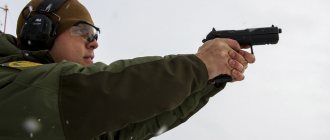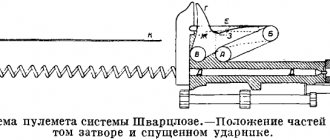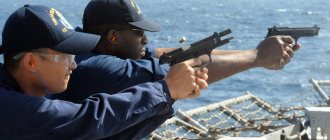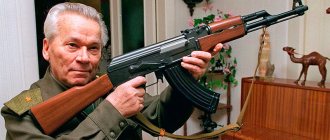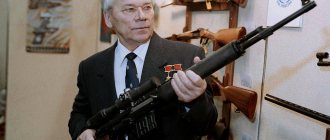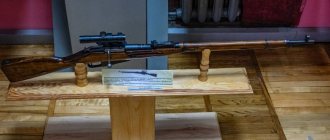Small arms are often underestimated, although in fact their importance is very high. Even if the “shooter” is not as attractive and interesting as nuclear weapons, combat aircraft or tanks, rifles and machine guns kill many more people.
Over the past 80 years, several types of small arms have radically changed the tactics of infantry units. Modern technology, combined with advances in polymers, metallurgy and metalworking, has made it possible to create lightweight and accurate weapons.
Here are five weapons that made modern combat as we know it.
Sturmgewehr 44
Photo: Armemuseum (The Swedish Army Museum) / wikimedia.org
World War II Germany was the first country to appreciate the importance of a weapon smaller than a rifle capable of firing long bursts. The German army, fighting the Soviet infantry on the Eastern Front, needed a weapon that would surpass the Mauser 98k repeating rifle in magazine capacity and rate of fire, and the MP-40 submachine gun in caliber.
The result of the search was the MP-44, also known as the Sturmgewehr 44 assault rifle. Originally developed from a submachine gun, the rifle used 7.92x33mm ammunition fed from a 30-round magazine. It could fire in automatic or semi-automatic mode at a speed of up to 600 rounds per minute. Externally, the Sturmgewehr 44 most closely resembles a rifle with a large curved magazine, short stock and pistol grip.
With the advent of the MP-44, it became clear that the new model was not a rifle or a submachine gun, but something completely new. In 1944, the new development officially received the name Sturmgewehr 44, becoming the world's first full-fledged machine gun.
Reasons for the degradation of the Japanese military-industrial complex
Japan's defeat in World War II, when it tried to conquer much of Asia, made many Japanese wary of a military buildup. The post-war Constitution limits the use of force to self-defense only, and the arms export ban was only lifted in 2014.
Since the establishment of the Procurement Agency, Japan has conducted a number of negotiations, most of which ended in failure. In particular, the Japanese offered India their US-2 ShinMaywa naval aircraft, but due to the price, the contract was never signed. Negotiations with Australia for the purchase of Soryu-class submarines also ended in failure.
US-2 Shin Maywa
Photo: Wikipedia
Kalashnikov assault rifle
Photo: US Air Force/Staff Sgt. Levi Riendeau / wikimedia.org
The Soviet army, realizing the capabilities of the StG 44, wanted to get its own machine gun. Tank sergeant Mikhail Kalashnikov, who was wounded in the battle of Bryansk, became involved in the creation of new small arms and became the creator of a new machine gun. His creation, like the StG 44, used a lighter cartridge and a larger magazine. The new assault rifle was adopted in 1947 and became known as the Kalashnikov assault rifle.
Although the AK was not the first assault rifle, it became the most influential assault rifle in the world. The Kalashnikov assault rifle used a lightweight 7.62 mm cartridge of the 1943 model, which allowed for improved control during automatic shooting. In addition, the AK, unlike other types of automatic weapons of that time, is very easy to disassemble. The assault rifles were made from stamped metal and other easily produced parts, allowing countries with modest manufacturing bases such as Albania, Cambodia and Sudan to produce their own copies of the AK.
The simplicity and reliability of the Kalashnikov assault rifle allow it to be used even in the most difficult conditions. The AK was used in almost all wars of independence. Russian soldiers continue to use the AK-74M and more modern AK-12s today.
LiveInternetLiveInternet
Quote from Tor-Vic
Read in full In your quotation book or community!
The evolution of Russian small arms
The 20th century can rightfully be called the century of wars. But they fought not only on the battlefield, the war was also going on in the design bureaus. The figure of the engineer-inventor came to the fore. Among small arms, the carbine is one of the most effective means of combat. Let's see how it has changed over the last century.
Back in 1885, Russian military designer Sergei Ivanovich Mosin (1849–1902) created what was then a unique rack and pinion magazine for an 8-mm repeating rifle. There were rumors that the French wanted to buy the development for 600 thousand francs, but Mosin refused to sell his invention. The final design of the rifle was “settled down” after the painstaking work of the Commission for testing repeating rifles. The Mosin magazine was supplemented with a cartridge and barrel developed by Colonel N.F. Rogovtsev and other members of the commission chaired by N.I. Chagin, and a cartridge loading system purchased from the Belgian Leon Nagant.
The rifle entered service with the Russian army in 1891 and served the Fatherland well during the Russo-Japanese, World War I, Russian-Finnish and World War II.
Infantry rifle of the Mosin system 1891
Main characteristics: Caliber: 7.62×54R Weapon length: 1306 mm Barrel length: 800 mm Weight without cartridges: 4 kg Magazine capacity: 5 rounds
Over its more than half a century of life, the rifle was modified several times. At first there were several varieties: infantry, dragoon and Cossack. By 1930, a single model appeared - the Mosin rifle model 1891/1930.
Mosin rifle model 1891/1930, pre-war release
Main characteristics: Caliber: 7.62×54R Weapon length: 1232 mm Barrel length: 729 mm Weight without cartridges: 4 kg Magazine capacity: 5 rounds
The rifle was later modified to a Model 1944 carbine.
Model 1944 carbine with permanent bayonet in firing position
Main characteristics: Caliber: 7.62×54R Weapon length: 1020 mm Barrel length: 517 mm Weight without cartridges: 4.1 kg Magazine capacity: 5 rounds
In 1944, the Mosin rifle was discontinued. However, it was precisely this that served as the basis for many subsequent developments of models of sports, hunting and ballistic weapons, which are still produced by the famous Russian Technologies State Corporation.
At the combat post, the Mosin rifle was replaced by the Simonov self-loading carbine (SKS). Its first samples began to enter the army back in 1945. It was developed specifically for the 7.62×39 mm intermediate cartridge, adopted in 1943, created by N. M. Elizarov and B. V. Semin.
Simonov self-loading carbine (SKS)
Main characteristics Caliber: 7.62×39 Weapon length: 1020 mm Barrel length: 520 mm Weight without cartridges: 3.8 kg Magazine capacity: 10 rounds
In the Soviet army, the SKS was in service simultaneously with the legendary Kalashnikov assault rifle. It was inferior to it in the density of fire, but somewhat superior in accuracy. At the end of the 50s, it was decided to unify small arms, and Kalashnikov finally ousted the SKS from the armed forces. But its production was established in many countries friendly to the USSR. SKS still remains popular in the world and is widely used, primarily for civilian purposes. Nowadays, the production of the OP-SKS model is carried out on the basis of SKS.
Self-loading carbine OP-SKS
Main characteristics Caliber: 7.62×39 Weapon length: 1025 mm Barrel length: 520 mm Weight without cartridges: 3.7 kg Magazine capacity: 10 rounds
The 7.62 mm Dragunov self-loading sniper rifle was developed in 1958–1963. under the leadership of Evgeniy Dragunov. The rifle mechanism is based on the action of powder gases diverted from the barrel bore to the gas piston. Designed specifically for conducting targeted fire from cover and destroying moving single targets.
SVD sniper rifle designed by Dragunov
Main characteristics Caliber: 7.62×54R Weapon length: 1225 mm Barrel length: 547 mm Weight without cartridges: 4.3 kg Magazine capacity: 10 rounds
SVD rifles are still in service with the Russian army. Today, Russian Technologies produces such variants of the Dragunov rifle as SVD and SVDS (with a folding stock).
SVDS sniper rifle with a folding stock and a shortened barrel
Main characteristics Caliber: 7.62×54R Weapon length: 1135/875 mm Barrel length: 565 mm Weight without cartridges: 4.7 kg Magazine capacity: 10 rounds
The prototype of the machine gun appeared in Russia at the beginning of the 20th century. It was created by the captain of the Russian Imperial Army V. G. Fedorov in 1913–1916.
Main characteristics Caliber: 6.5×50SR Weapon length: 1040 mm Barrel length: 520 mm Weight without cartridges: 4.3 kg Magazine capacity: 25 rounds
Its mass production was never established. The machine lacked reliability; it was difficult to manufacture and operate. However, it was he who became the first example of individual automatic weapons and played an important historical role in the subsequent development of small arms. The Kalashnikov assault rifle is probably the most famous Russian weapon. It was developed by Mikhail Kalashnikov in 1947–1949 and adopted by the Soviet Army in 1949.
Kalashnikov assault rifle AK-47, 1947–1949
Main characteristics of the AK-47 Caliber: 7.62×39 Weapon length: 870 mm Barrel length: 414 mm Weight without cartridges: 3.8 kg Magazine capacity: 30 rounds
AK is the most common weapon in the world. Over the past 60 years, more than 70 million Kalashnikov assault rifles of various modifications have been produced in the world. This weapon is in service in 50 countries around the world. For comparison: the American M16 rifle was produced in the amount of 10 million units, it is used in 27 countries around the world. Today there are a huge number of modifications of the machine.
Kalashnikov AK-47 assault rifle, 1949-1954.
Kalashnikov AKS-47 assault rifle, 1954-1959.
In recent years, a large number of Kalashnikov assault rifles of the so-called “hundredth series” (AK-101, AK-102, AK-103 and AK-104) have been produced specifically for export. For example, in 2006, Izhmash, through Rosoboronexport, signed a contract with Venezuela for the supply of 100 thousand AK-103 assault rifles. This contract became the largest for Izhmash over the past 25 years.
Kalashnikov assault rifle AK-103
Main characteristics: Caliber: 7.62×39 Weapon length: 943/700 mm Barrel length: 415 mm Weight without cartridges: 3.4 kg Magazine capacity: 30 rounds
The AK-105 series assault rifles are created specifically for the Russian armed forces and law enforcement agencies.
Kalashnikov AK-105 assault rifle
Main characteristics Caliber: 5.45×39 Weapon length: 824/586 mm Barrel length: 314 mm Weight without cartridges: 3.4 kg Magazine capacity: 30 rounds
The newest model of the Kalashnikov assault rifle was released at Izhmash in 2012. The designer of the machine gun was Vladimir Zlobin. The AK-12 will have to replace outdated models (AK-74, AK-74M, AK-103) in service with the Russian army.
Kalashnikov AK-12 assault rifle
Caliber: 5.45×39, 5.56×45, 7.62×39; 7.62×51 NATO Weapon length, mm: 945/725 Barrel length, mm: 415 Weight without cartridges: 3.3 kg Magazine capacity, cartridges: 30 or 60
A huge number of military and civilian weapons are produced on the basis of the Kalashnikov assault rifle. In recent years, Izhmash has been successfully developing the Saiga series of rifles and carbines. The latest model of the Saiga-12 self-loading carbine is now being purchased even for arming US police units. Thanks to the efficiency improvement program implemented at Izhmash by the Russian Technologies Corporation, sales markets have been significantly expanded over the past year. For example, shipment volumes to the US market increased by 50%.
Saiga-12
Saiga-12 is a 12 gauge smoothbore shotgun. Can fire shotgun and slug cartridges, including Magnum, with case lengths of 70 and 76 mm. The carbine can fire single fire and has automatic reloading. There are 4 variants of Saiga: Saiga-12, Saiga-12S, Saiga-12K, Saiga-12S EXP-01.
Saiga-12K
The Nikonov assault rifle is another excellent example of an assault rifle. It was developed by Gennady Nikonov in the early 90s. The AN-94 model has also been produced at Izhmash since 1998. AN-94 is a new generation of automatic weapons. By improving the accuracy of fire from unstable positions, it is 1.5 times superior to previous models in terms of combat effectiveness. The machine gun allows you to fire single shots, fixed bursts and continuous fire. The rate of fire reaches 1800 rounds per minute.
Nikonov AN-94 assault rifle
Main characteristics Caliber: 5.45×39 Weapon length: 943/728 mm Barrel length: 405 mm Weight without cartridges: 3.85 kg Magazine capacity: 30 rounds
The SV-99 sniper rifle chambered for a 5.6 mm rimfire cartridge was developed in 2001 specifically for anti-terrorist missions. The base was the Biathlon-7-2 sports rifle. The crank-connecting rod locking mechanism equipped with the SV-99 allows firing at a fast pace. The rifle is in service with riot police units.
Sniper rifle SV-99
Main characteristics Caliber: 5.6×15 Weapon length: 1030 mm (with stock and silencer) Barrel length: 350 mm Weight without cartridges: 3.8 kg Magazine capacity: 5 or 10 rounds
It is clear that the production of weapons is not the most innocent activity. But on the other hand, who knows what would have happened to us and our country if not for military production?
M16
Photo: Staff Sergeant Bradley Rhen / wikimedia.org
The M16 rifle was a "wonder weapon" that quickly gained a reputation for being unreliable once it entered service. It all started well enough - in 1956, Eugene Stoner patented the design of an AR-15 rifle, equipped with a gas release mechanism with direct action of powder gases on the bolt frame. The simple design, the use of aluminum and plastic made it possible to create a very light weapon. The maximum rate of fire is 750 rounds per minute, the initial speed of the bullet is about 990 meters per second.
The new assault rifle, called the M16, was loved by the Americans who served in Vietnam for its lightness and compactness compared to the M-14 rifle. In addition, with an equal number of cartridges, its ammunition weighed lighter. Unfortunately, changing grades of gunpowder and the unfounded belief that new weapons did not require frequent cleaning caused many problems on the battlefield. After a number of modifications, the M16 became a highly effective automatic rifle. The innovative use of plastic and aluminum has led to the creation of even lighter firearms. Variations of the famous rifle, such as the M16A4 and M4A1, are still used by the US Army and Marine Corps.
How to sharpen Hitler's saw
Next comes the real retro. What do the single Bundeswehr MG3 machine gun, the Austrian Steyr MG-74, the Yugoslav/Serbian Zastava M53 and the Swiss SIG MG 710−3 have in common? It’s simple: they are reincarnations, or rather, variations of the Wehrmacht MG42 machine gun, adopted for service back in 1942, which the Americans nicknamed “Hitler’s saw” and “bone cutter” for its deadly efficiency.
The military leadership of the Third Reich announced a competition for a new machine gun in the late 1930s. The MG 34 then in service was good, but expensive and difficult to manufacture: more than a hundred milled parts, 150 hours of working time, about 312 Reichsmarks. Meanwhile, a single machine gun was the basis of the firepower of the infantry section of the German army, and the growing Wehrmacht required more and more of such weapons. Therefore, we needed a model with high combat qualities, but as cheap and technologically advanced as possible.
The small, little-known company Metall und Lackierwarenfabrik Johannes Grossfuss AG won the competition. The machine gun she proposed (later it received the designation MG 42) turned out to be simple and very reliable; stamping was widely used in its production, so the cost was almost a third lower than that of the MG 34, and the metal consumption was half.
Wehrmacht soldiers with an MG 42 machine gun, 1944. Illustration: Michael Cremin/Vostock Photo
The weapon was built on the basis of an automatic weapon with a short barrel stroke, the bolt was locked using two rollers. The MG 42 had a high rate of fire - up to 1335 rounds per minute. This is more than twice as high as a Maxim machine gun or a Kalashnikov assault rifle. At such a frantic pace, the barrels quickly overheated, so the MG 42 had a mechanism for quickly replacing them - the operation took less than 10 seconds.
Today, many experts call the MG 42 the best machine gun of World War II. It is not surprising that officials of the Bundeswehr created after the war did not want to part with him. They only “changed the sharpening” of the “Hitler saw” - they remade it for a single NATO cartridge 7.62x51 mm and in 1958 they put it into service under the designation MG 1 (the previous name caused unnecessary associations). It is interesting that the Germans initially purchased components for its production from their former opponents - the Americans and the British, who had substantial arsenals of captured MG 42s.
A little later, about 60 small changes were made to the design of the machine gun - the design of the sight, muzzle, materials and production technology of barrels and chambers, etc. The updated machine gun under the designation MG3 entered service in 1960 and remains in service to this day.
Austrian soldiers with an MG3 machine gun during a training exercise, 2014. Illustration: Justin De Hoyos/Wikimedia commons
In addition to Germany, its production was established in about a dozen countries, including Turkey, Pakistan, Italy, and Greece. In Germany itself, at the beginning of the 21st century, they decided that the machine gun was morally obsolete. They did not remove it from service, but stopped production and decided over time to replace it with two models from Heckler&Koch - the HK MG 4 in 5.56x45 caliber and the NK MG 5 in 7.62x51 caliber. But so far things are not going well with the replacement; moreover, this year the German military department decided to update the existing MG 3 fleet and, due to the lack of its own production, purchased a batch of machine guns from Turkey.
Machine gun MG34/42
Photo: Andrew Bossi / wikimedia.org
The German MG34 machine gun was one of the first light single machine guns with belt ammunition. It was developed by Mauser for German rearmament in the 1930s. Due to restrictions on the size of the German army at the time, the MG34 was produced in small quantities, allowing factories to ramp up production without rushing. As a result, the machine gun, each of which took more than 100 hours to create, worked exactly like a clock.
Several features made the MG34 a truly revolutionary machine gun. Among them are quick barrel changes in combat conditions, easy loading of cartridge belts, air cooling and a rate of fire of about 750 rounds per minute. The MG34 was powered by 50-round belts that could be interconnected, as well as drum magazines. The most important thing was that the machine gun turned out to be quite light - it weighed “only” about 12 kilograms, while the mass of its predecessor was about 20 kg (without the machine, water and tape - approx. “RG”).
All these features made it possible to create a weapon that became one of the pillars of the German army of that time. Each squad had one MG34, which could be used both for suppression fire and for strengthening defensive positions. During the war, the Soviet Union, Great Britain and the United States had nothing similar at the branch level. A later version of the machine gun, called the MG42, was almost identical to the original, but was made from stamped parts to speed up and reduce the cost of production under wartime conditions.
How to get out of this situation
Despite resuming arms exports only 7 years ago, Japan has a chance to become more competitive. To do this, they should focus on the development of UAVs, autonomous vehicles, supersonic weapons, as well as spacecraft and cyberspace.
China is already active in this field. Therefore, billions of dollars are needed to finance all plans. Japan has the money for this. In particular, the ministry requested a record budget of 291 billion yen for 2022, which is 38% more than the current one.
Let us remind you that Britain and Japan will create a jet engine for a new generation of fighters.
M1 Garand
Photo: US Navy photo by Journalist 1st Class Brian Brannon / wikimedia.org
The M1 Garand was the first semi-automatic rifle adopted as a primary infantry weapon. Although a trained fighter could quickly empty the five-round magazine of a Kar98k or Arisaka rifle, working the bolt, especially while moving, distracted from the battle. At the same time, an American soldier could quickly fire 8 shots before running out of ammunition.
Ammunition was supplied in packs of 8 rounds of 7.62×63 mm (.30-06 Springfield) cartridges, inserted through an open bolt. After the cartridges are used up, the pack is thrown out through an open window at the top of the receiver with the bolt open. The gas piston is fixedly attached to the bolt frame. Locking the bolt by turning occurs when the bolt is rotated around the longitudinal axis and the two lugs of the bolt enter the grooves of the receiver. It is believed that this scheme was used to create the Kalashnikov assault rifle.
The M1 Garand rifle provided American soldiers with fire superiority in close combat. Ten soldiers armed with these rifles could quickly fire up to 80 rounds without reloading, while the Germans and Japanese could fire no more than 50 rounds. This gave the Americans an important combat advantage.
FN FAL
FN FAL is a classic automatic rifle made in Belgium. This is one of the most popular and widespread light automatic rifles in the world. The weapon was used in many military conflicts (Vietnam War, Gulf War, etc.). Production began in the 50s and continues today. FAL gained its fame due to its ease of use, maintenance, reliability and efficiency. The rifle fires up to 700 rounds per minute. Since its production, a huge number of modifications of this model have been produced, which were in service in more than 90 countries. FN FAL is currently being released in 13 countries around the world. In total, more than 20 million copies were produced.
RPG-7
RPG-7 is the best Soviet/Russian hand-held anti-tank grenade launcher. The main purpose of the weapon is to destroy tanks and other enemy armored vehicles. The RPT-7 is also capable of hitting air targets and destroying shelters. The grenade launcher has been actively used from 1968 to the present in all military conflicts. The demand for the RPG-7 is explained by its powerful efficiency. The main advantages of the design are simplicity and ease of use, reliability and lack of recoil. Over the entire period, more than 9 million copies of this weapon were produced. It was in service in more than 40 countries around the world and is used in many countries to this day.




